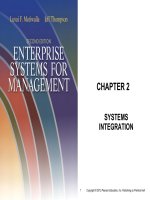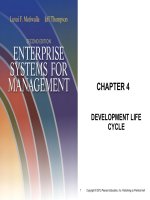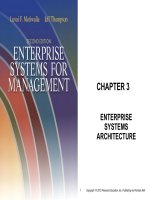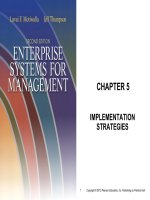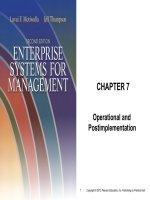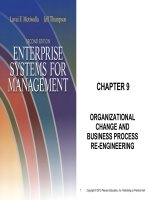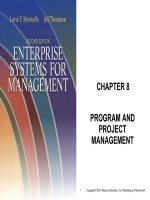Principles of operations management 9th by heizer and render chapter 06s
Bạn đang xem bản rút gọn của tài liệu. Xem và tải ngay bản đầy đủ của tài liệu tại đây (781.24 KB, 77 trang )
6
SUPPLEMENT
Statistical
Process Control
PowerPoint presentation to accompany
Heizer and Render
Operations Management, Eleventh Edition
Principles of Operations Management, Ninth Edition
PowerPoint slides by Jeff Heyl
© 2014
© 2014
Pearson
Pearson
Education,
Education,
Inc.Inc.
S6 - 1
Outline
►
►
►
Statistical Process Control
Process Capability
Acceptance Sampling
© 2014 Pearson Education, Inc.
S6 - 2
Learning Objectives
When you complete this supplement
you should be able to :
1. Explain the purpose of a control chart
2. Explain the role of the central limit theorem
in SPC
3. Build
x-charts and R-charts
4. List the five steps involved in building
control charts
© 2014 Pearson Education, Inc.
S6 - 3
Learning Objectives
When you complete this supplement
you should be able to :
5. Build p-charts and c-charts
6. Explain process capability and compute Cp
and Cpk
7. Explain acceptance sampling
© 2014 Pearson Education, Inc.
S6 - 4
Statistical Process Control
The objective of a process control
system is to provide a statistical
signal when assignable causes of
variation are present
© 2014 Pearson Education, Inc.
S6 - 5
Statistical Process Control
(SPC)
►
Variability is inherent
in every process
►
Natural or common
causes
►
Special or assignable
causes
►
Provides a statistical signal when assignable
causes are present
►
Detect and eliminate assignable causes of
variation
© 2014 Pearson Education, Inc.
S6 - 6
Natural Variations
►
Also called common causes
►
Affect virtually all production processes
►
Expected amount of variation
►
Output measures follow a probability
distribution
►
For any distribution there is a measure of
central tendency and dispersion
►
If the distribution of outputs falls within
acceptable limits, the process is said to be
“in control”
© 2014 Pearson Education, Inc.
S6 - 7
Assignable Variations
►
Also called special causes of variation
►
Generally this is some change in the process
►
Variations that can be traced to a specific
reason
►
The objective is to discover when assignable
causes are present
►
Eliminate the bad causes
►
Incorporate the good causes
© 2014 Pearson Education, Inc.
S6 - 8
Samples
To measure the process, we take samples and
analyze the sample statistics following these
steps
Each of these
represents one
sample of five
boxes of cereal
(a) Samples of the product,
say five boxes of cereal
taken off the filling machine
line, vary from each other
in weight
Frequency
# #
# # #
# # # #
# # # # # # #
#
Figure S6.1
© 2014 Pearson Education, Inc.
# # # # # # # # #
Weight
S6 - 9
Samples
To measure the process, we take samples and
analyze the sample statistics following these
steps
Frequency
(b) After enough samples
are taken from a stable
process, they form a
pattern called a
distribution
The solid line
represents the
distribution
Weight
Figure S6.1
© 2014 Pearson Education, Inc.
S6 - 10
Samples
To measure the process, we take samples and
analyze the sample statistics following these
steps
(c) There are many types of distributions, including the normal (bellshaped) distribution, but distributions do differ in terms of central
tendency (mean), standard deviation or variance, and shape
Frequency
Figure S6.1
Central tendency
Weight
© 2014 Pearson Education, Inc.
Variation
Weight
Shape
Weight
S6 - 11
Samples
To measure the process, we take samples and
analyze the sample statistics following these
steps
Prediction
Frequency
(d) If only natural causes of
variation are present,
the output of a process
forms a distribution that
is stable over time and is
predictable
e
Tim
Weight
Figure S6.1
© 2014 Pearson Education, Inc.
S6 - 12
Samples
To measure the process, we take samples and
analyze the sample statistics following these
steps
Prediction
Frequency
(e) If assignable causes are
present, the process output
is not stable over time and
is not predicable
?
?? ??
?
?
?
?
?
?
?
?
?
??
??
?
e
Tim
Weight
Figure S6.1
© 2014 Pearson Education, Inc.
S6 - 13
Control Charts
Constructed from historical data, the
purpose of control charts is to help
distinguish between natural variations
and variations due to assignable causes
© 2014 Pearson Education, Inc.
S6 - 14
Process Control
Frequency
Lower control limit
(a) In statistical
control and capable
of producing within
control limits
Upper control limit
(b) In statistical control
but not capable of
producing within
control limits
(c) Out of control
Size
(weight, length, speed, etc.)
© 2014 Pearson Education, Inc.
Figure S6.2
S6 - 15
Control Charts for Variables
►
Characteristics that can take any real value
►
May be in whole or in fractional numbers
►
Continuous random variables
x-chart tracks changes in the central
tendency
s
R-chart indicates a gain or loss eoftwo chart
es
d
h
e
T
s
u
dispersion
e
b
t
s
u
m
r
e
h
t
e
to g
© 2014 Pearson Education, Inc.
S6 - 16
Central Limit Theorem
Regardless of the distribution of the population,
the distribution of sample means drawn from the
population will tend to follow a normal curve
1) The mean of the sampling
distribution will be the same as the
population mean
2) The standard deviation of the
sampling distribution ( x) will
equal the population standard
deviation () divided by the
square root of the sample size, n
© 2014 Pearson Education, Inc.
=
x
x
n
S6 - 17
Population and Sampling
Distributions
Population
distributions
Distribution of
sample means
=
Mean of sample means = x
Beta
Standard
deviation of
the sample
means
Normal
x
n
Uniform
|
|
|
3 x 2 x 1 x
|
=
x
|
|
1 x 2 x 3 x
95.45% fall within ± 2 x
99.73% of all x
fall within ± 3 x
© 2014 Pearson Education, Inc.
|
Figure S6.3
S6 - 18
Sampling Distribution
Figure S6.4
Sampling
distribution of
means
Process
distribution of
means
=
x=
(mean)
© 2014 Pearson Education, Inc.
S6 - 19
Setting Chart Limits
For x-Charts when we know
=
Lower control limit (UCL) x
z x
=
Upper control limit (UCL) x
z x
Where
=
x
= mean of the sample means or a target value set
for the process
z = number of normal standard deviations
/ n
x = standard deviation of the sample means
=
n =
© 2014 Pearson Education, Inc.
population (process) standard deviation
sample size
S6 - 20
Setting Control Limits
▶ Randomly select and weigh nine (n = 9) boxes
each hour
Average weight in 17 13 16 18 17 16 15 17 16
16.1 ounces
the first sample
9
WEIGHT OF SAMPLE
WEIGHT OF SAMPLE
WEIGHT OF SAMPLE
HOUR
(AVG. OF 9
BOXES)
HOUR
(AVG. OF 9
BOXES)
HOUR
(AVG. OF 9
BOXES)
1
16.1
5
16.5
9
16.3
2
16.8
6
16.4
10
14.8
3
15.5
7
15.2
11
14.2
4
16.5
8
16.4
12
17.3
© 2014 Pearson Education, Inc.
S6 - 21
Setting Control Limits
12
Avg of 9 boxes
Average mean = i1
x
of 12 samples
12
© 2014 Pearson Education, Inc.
=
16 ounces
x
n 9
z 3
1 ounce
S6 - 22
Setting Control Limits
12
Avg of 9 boxes
Average mean = i1
x
of 12 samples
12
=
16 ounces
x
n 9
z 3
1 ounce
1
1
UCL x x z x 16 3
16 3 17 ounces
3
9
=
1
1
LCL x x z x 16 3
16 3 15 ounces
3
9
=
© 2014 Pearson Education, Inc.
S6 - 23
Setting Control Limits
Control Chart
for samples
of 9 boxes
Variation due
to assignable
causes
Out of
control
17 = UCL
Variation due to
natural causes
16 = Mean
15 = LCL
| | | | | | | | | | | |
1 2 3 4 5 6 7 8 9 10 11 12
Sample number
© 2014 Pearson Education, Inc.
Out of
control
Variation due
to assignable
causes
S6 - 24
Setting Chart Limits
For x-Charts when we don’t know
=
UCL x x
A2 R
=
LCL x x
A2 R
n
where
R
=
x
R
i
i1
n
samples
A2 =
S6.1
=
© 2014 Pearson Education, Inc.
average range of the
control chart factor found in Table
mean of the sample means
S6 - 25


